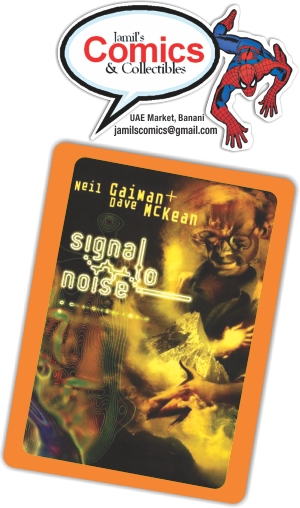

Signal to Noise
Story: Neil Gaiman
Art: Dave McKean
Reviewed by Munawar Mobin
When Neil Gaiman decides to write a short story and have it penned and brought to life by none other than the out-of-the-world talented Dave McKean, it's a huge turnout, in terms of expectations. It's like Marley and Bob Dylan recording together. Expectations with the gigantic magnitude.
The story is simple, yet fascinating. It's about a film-maker being told he has cancer and the demons he faces due to the expiration date on his life. He wants to make one last movie before he dies, and he wants to make it about the end of the world. In his head, the story swings from panel to panel, sometimes rendering bits of thoughts from the unnamed film-maker's mind and most times, spinning the sad tale of the film-maker himself. Gaiman's wording makes even the most optimistic of people believe that the world is a cold cruel place.
Signal to Noise doesn't fall anywhere short of outstanding. It's one of those books with those specific stories and plot twists which are so obvious but ones which, when read by other writers, have them slapping their heads for not thinking it up themselves. The direction of the story, the flow of the words, the atmosphere it managed to create, all of it seems to come together so elegantly and smoothly, and the best part is that even when you realise that you know what might happen next, you're still pleasantly surprised when your prediction comes true. That's where Dave McKean comes in.
Dave McKean is like the Neil Armstrong of comic book art. His level of talent and his trails of thought are astounding. They're high up there with the rest of heaven. Without Dave's brush strokes, editing, and brilliant combination of colours, the novel would never have been as good as it is. His artwork puts on a completely new layer of metaphors on the already metaphorically well-built storyline.
The panels flow from one way to the other: sometimes pictures of clocks, sometimes of movie stars, sometimes actual images, and at others, regular objects given irregular behaviour patterns. It's as if Dave McKean looks at the world through completely different eyes. His left eye sees the world through a little child's head while his right serves up a much older, perhaps 97-year-old's view.
Neil Gaiman and Dave McKean - A crisp, delicate and insane combination that makes the reader wonder how fast they can get a hold of something else put together by these geniuses. God has done right with these two.
The ending is one that makes the reader feel duped. It brings about a state of confusion and (for me) paranoia. There's no way of telling what the point of the story was, nor is it possible to find a way in which the novel can be deemed 'useless'. It's a confusing but satisfying feeling, but that's why comics aren't just pictures and stories. They're art.


